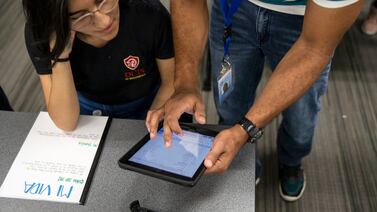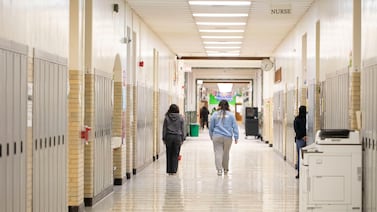Michigan’s four-year high school graduation rate reached its highest level in 16 years.
It’s welcome news in a state where nearly 1 in 3 students is chronically absent, and test scores show many students remain below proficiency in English language arts and math.
Michigan’s four-year high school graduation was 82.83% in the 2023-24 school year, up slightly from the previous year and above pre-pandemic numbers, according to data released Friday by the state Center for Educational Performance and Information.
The Class of 2024 entered high school in 2020 as the pandemic altered the way schools delivered instruction.
To calculate the graduation rate, the state uses a model that measures the time it takes for ninth grade students to earn a high school diploma. That formula has been used since the 2007-08 school year.
Michigan’s high school dropout rate slightly lowered as well, at 7.68% for the Class of 2024, compared with 8.13% the previous year.
Some students take longer than four years to graduate, including those in early middle college programs who take five years but leave high school with a diploma and an associate degree or other advanced certificate. The state also publishes five- and six-year graduation rates.
It’s not clear yet how Michigan’s graduation rate compares nationally. During the 2022-23 school year, the national rate was 87%. A rate for the 2023-24 school year isn’t available.
Superintendents told Bridge Michigan and Chalkbeat they are providing students with ways to recover learning or credit through after-school tutoring, virtual classes, and summer school. They say these efforts are paying off based on improved graduation rates.
How one district improved its rate
Ecorse Public Schools, just outside of Detroit, had a four-year graduation rate of 74.81% in the 2023-24 school year, a jump of 14 percentage points from the 2022-23 school year and nearly 8 percentage points higher than it was before the pandemic.
For three years during the pandemic, many high school students at Ecorse attended tutoring sessions two days a week after school. That tutoring, which was mandatory for some, meant the school day was extended for two hours. Teachers were paid more to stay late, and the district provided transportation home for students, a key feature given many students are bused in from Detroit. Federal COVID relief money paid for that investment.
The gains, Ecorse Superintendent Josha Talison said, validate the work of the district’s staff, who “were really on the kids,” to make sure they were learning and getting the help they needed. Talison said the improvement also “shows how we spent the money in an effective way.”
The district over the years has overhauled its curriculum and instruction across all grades and subjects, working to increase academic rigor and support for students.
“If you’re going to do things transformationally at the high school, it has to start at the kindergarten level,” Talison said.
That federal money is now gone, and the district has focused its efforts on providing a “myriad of supports for our high school students” within the regular school day.
The district enrolls 1,150 students, more than 80% of whom are eligible for a free- or reduced-price lunch and 42% of whom live in extreme poverty.
“We’re working very hard to make sure our student’s zip code doesn’t dictate,” how well they can achieve, Talison said.
From the highs in Marquette to the lows in Flint
Here’s what the rates looked like in several other Michigan districts:
- Airport Community Schools in Monroe County had a four-year graduation rate of 86.36%, up from 79.82% the previous year and similar to the 86.27% pre-pandemic rate. The dropout rate was 9.09%, compared to 16.06% the previous year and 6.01% pre-pandemic.
- Detroit Public Schools Community District had a four-year graduation rate of 78.09%, up from 74.26% the previous year and 75.84% pre-pandemic. The district’s dropout rate was 16.15%, a slight decrease from the previous year but well above the pre-pandemic rate of 11.71%.
- Flint Community Schools had a four-year graduation rate of 44.55%, up from 35.03% the year before and well below the pre-pandemic rate of 64.85%. The district’s dropout rate saw a small decrease to 33.66%, from the 34.46% rate the previous year. But it has soared since the pre-pandemic rate of 19.8%.
- Grand Rapids Public Schools had a four-year graduation rate of 82.53%, up from 82.39% the previous year and 76.2% pre-pandemic. The district’s dropout rate was 10.37%, up from 7.48% the previous year but in line with its pre-pandemic rate of 10.34%.
- Kalamazoo Public Schools had a four-year graduation rate of 75.31%, up from 65.85% the previous year and above the pre-pandemic rate of 73.44%. The dropout rate was 10.48%, down from 16.27% the previous year but up from 8.89% pre-pandemic.
- Marquette Area Public Schools had a four-year graduation rate of 91.22%, up from 87.4% the previous year and 84.48% pre-pandemic. The dropout rate of 1.15% was similar to the previous year and lower than the 4.14% pre-pandemic rate.
Getting students ‘across that line’
The stakes are high.
“In today’s world, if you don’t have a high school diploma, it’s just awfully hard to get ahead and not live in poverty,” Traverse City Area Public Schools Superintendent John VanWagoner said.
His district offers traditional high school with an early middle college option and an alternative high school where students who have fallen behind on credits or need a smaller learning environment attend.
At the alternative high school, the district is trying to improve the graduation rates by offering online courses that allow students to take more than their typical courseload. The district also offers summer school and dual enrollment options where students can earn both college and high school credit at the same time.
The alternative high school had a 25.64% four-year graduation rate and a 47.89% six-year graduation rate. The district graduation rates were 88.45% and 91.62%, respectively.
VanWagoner said it’s important “now more than ever” to ensure staff is working to build relationships with students, citing that many are homeless.
At Lansing School District, Superintendent Ben Shuldiner credited teachers, principals, and graduation support specialists for creating a sense of trust with students. He said the district’s 5.04% dropout rate — a significant drop from 17.35% in 2020-21 school year — showed students are staying connected to their school even if they are unable to complete their degree in four years.
The district’s four-year graduation rate was 88.34%, up from 62.1% during the 2020-2021 school year.
Bridge Michigan previously reported that Lansing district leaders monitor student data closely, have protocols for following up with students and parents when students miss school, and offer multiple ways for students to make up missing credits.
For VanWagoner in Traverse City, the goal is “get kids across that line and with some additional experiences” as employers’ jobs demand more skills than a high school diploma represents.
Role of career, other education programs
State Superintendent Michael Rice credited career technical education and other programs as reasons for the increased graduation rate.
“These rigorous secondary school programs — CTE, dual enrollment, early middle college, advanced placement, and international baccalaureate — contribute to improved graduation rates by engaging students deeply in learning,” Rice said in a statement. “When students are exposed to courses of study that interest them, they are more likely to graduate — and at the same time are preparing for rewarding careers.”
Not all students have the same rate of success. The four-year rate for students from low-income homes was 73.12%, while it was 60.97% for students with disabilities, and 59.53% for students experiencing homelessness.
Graduation and dropout rates do not add up to 100% because the state also considers students who receive a special education certificate of completion, earn a different certification, age out of special education services, complete a GED, and those who are still in school working toward a high school diploma, according to an explanation of the model from the state Center for Educational Performance and Information.
Isabel Lohman is a reporter for Bridge Michigan. You can reach her at ilohman@bridgemi.com
Lori Higgins is the bureau chief for Chalkbeat Detroit. You can reach her at lhiggins@chalkbeat.org.






